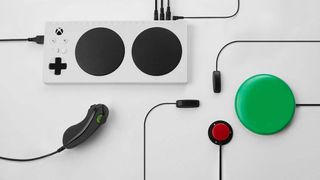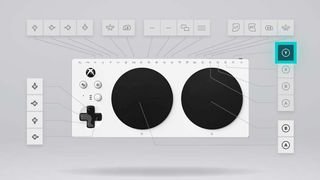How video game accessibility will improve on the Xbox Series X and PS5
How next-gen consoles will tackle accessibility

I’ve been disabled since infancy. Though it has impacted some facets of my life, it has never been a major hindrance. This is especially true when it comes to video games. With the exception of VR gaming, which still has a long way to go with regards to accessibility, not having full use of my legs has never impacted my ability to play video games.
But my experience is my own and there are other gamers with disabilities who cannot pick up a controller and play as I can. Some may not have full use of their hands or may not be able to see well (or at all). For decades, gamers with disabilities were an afterthought to developers and publishers — if they were even considered at all. Thankfully, things have started to change.
Thanks to the work of organizations like the AbleGamers Charity, accessibility in gaming has gained traction, particularly during the previous console generation (PS4, Xbox One, Nintendo Switch). More and more, we’re seeing major companies like Sony, Microsoft, and Ubisoft add a slew of accessibility options to their titles. With the current console generation in its infancy, accessibility in games will only continue to grow. In fact, games without accessibility features are fast becoming a thing of the past. This is great, especially for those who have longed for the day when accessibility would become ubiquitous.
Microsoft is at the forefront of accessibility. The company released its Xbox Adaptive Controller in 2018 for gamers with limited motor function. Though not perfect, the device is widely praised by the gaming industry and community. Its genius design comes from a high level of customization that allows users to connect their own switches and peripherals. This is important since no two gamers with disabilities share the same circumstances. The Xbox Adaptive Controller is the gold standard for accessibility and is compatible with the Xbox Series X right out of the box. It is the spearhead of Microsoft’s accessibility initiative.
“At Xbox, accessibility means that everyone — regardless of their level of play, their background or physical abilities — is welcome to play,” said Brannon Zahand, the Senior Gaming Accessibility Program Manager at Microsoft. “We pursue this by focusing on accessibility in product design from the start, to deliver adaptive and enjoyable experiences for all players – it’s about being able to customize your gaming experience to play in a way that’s right for you.”

“When we looked at accessibility in the next generation of consoles, we decided to start by prioritizing compatibility and continuity from Xbox One to Xbox Series X|S.," he continued, "For example, the Xbox Adaptive Controller is compatible with the new consoles, which allows players to seamlessly transition by reducing the learning curve and minimizing the costs to upgrade."
Microsoft focused on incremental, but meaningful improvements for the next-gen consoles, like adding tactile indicators on the rear of the Xbox Series X and Xbox Series S consoles, "They’re a great example of intentional and inclusive design; whether one has low or no vision, or simply can’t see around their console on the shelf, this small addition will improve the experience of using our Xbox consoles."
Stay in the know with Laptop Mag
Get our in-depth reviews, helpful tips, great deals, and the biggest news stories delivered to your inbox.
“ Another addition to the Xbox Series X package is the textured grips on the Xbox Wireless Controller, which, as Zahand explains, can help those with fine motor disabilities just as well as those who get sweaty hands during gameplay. They're small things, but they're meant to help as many people as possible.
“Looking forward, we have a number of areas we’re exploring based on the amazing feedback we continue to receive from our partners in the Gaming & Disability Community. While I don’t have anything to announce right now, I can say that we are taking a holistic approach to how we think about improving our products and services. It’s not just about adding another feature here or there; we want every interaction, whether you are a consumer or a developer, to be delightfully inclusive.”

Microsoft isn't only the company addressing the unique needs of disabled gamers. Sony Interactive Entertainment’s critically acclaimed video game The Last of Us 2 included over 60 accessibility options when it launched in June. This includes vision, hearing, and motor accessibility presets, alternate controls, magnification and visual aids, motion sickness, navigation and traversal assistance, text-to-speech and audio cues, combat accessibility, and much more.
In a post on the PlayStation Blog, Naughty Dog Lead Systems Designer, Matthew Gallant wrote: “Building upon the foundations we established with Uncharted 4: A Thief’s End, The Last of Us Part II features more than 60 accessibility settings, with expanded options focused on fine-motor and hearing, as well as completely new features that benefit low-vision and blind players. We encourage everyone to take advantage of these features to create a gameplay experience that’s right for them.”
Gallant brings up a great point about accessibility in games. It’s not enough to incorporate these features in hindsight. They must be built-in from the very beginning. Microsoft agrees.
“At #GAconf, a game accessibility conference I participated in recently, someone talked about the notion of accessibility being ‘baked-in’ versus ‘caked-on.’ Take adjustable UI text scaling, for example. This allows gamers to increase or decrease a game’s text size and can be incredibly useful for folks who have smaller screens, those who sit farther away from their screens, or those with low vision," Zahand said.
He added, "If you wait until your game is in beta to think about adding resizable UI text, you’re going to find yourself in a tough position. Trying to cake-on’ that functionality will require a lot of redesign and code churn, and you’re likely to end up with a less-than-stellar experience."
“However, if you are ‘baking-in’ inclusive and adaptive UI from the very beginning of your product’s development, that functionality will come about organically and will be much less costly and time-intensive to implement. You’ll also end up with an experience that will be more delightful and more useful for all of your players. So, ultimately, the biggest hurdle is getting game designers to design inclusively at the earliest stages of development… baking it in, instead of caking it on.”

This notion is echoed by Ubisoft, whose recent titles: Watch Dogs Legion and Assassin’s Creed Valhalla, include a host of accessibility features.
“We’ve made a lot of progress over the past few years in providing deeper customization options in all our games,” says David Tisserand, Sr. Manager of Accessibility. “But we recognize that this is not enough to remove all the barriers players may face. Hence we are working to ensure we design games with accessibility in mind from the get-go, so it’s seamlessly integrated into the design process. We started recruiting experts in the field who are working closely with our dev teams as early as possible.”
Ubisoft also takes accessibility beyond its games. Speaking personally, Ubisoft has gone out of its way to accommodate me at their press events. This includes ensuring my needs are met when flying to and from a location, booking accessible hotel rooms, and even getting accessible taxi services. I don’t need to worry about accessibility issues when attending Ubisoft events since the company makes it a top priority.
“For us,” said Tisserand, “accessibility is about removing barriers from the end-to-end player experience so that as many players as possible can enjoy our games. For example, we made great strides in making our events, both in-person and digital, more accessible in order to include everyone in the conversation. Our Customer Support is now designed to efficiently receive accessibility feedback and share it with the development teams. We’re all learning as fast as we can so we can keep improving the accessibility of our players’ experience going forward.”
While it’s easy to say your company wants to include accessibility features, implementing them presents its own challenges. This includes major features like button remapping or even smaller things like subtitles and UI.
“For a long time, subtitles in games were the exception and not the rule. That’s changed drastically in the last few years, but now the challenge is ensuring those subtitles are providing value for customers who rely on them. Common issues include a lack of speaker identification, small font size, poor contrast ratios between the text foreground and background, etc," Tisserand said. "So, we are working hard to educate developers on how to create robust subtitle systems that are useful for as many people, on as many types of devices, as possible."
So how is Ubisoft tackling these hurdles? One way is through its Xbox Accessibility Guidelines (XAGs), which provide developers with best practices to help make their games more inclusive. There is also an entire XAG dedicated to Subtitles and Captions that developers can use to ensure their subtitles are as inclusive as possible. And in development are short, easy-to-digest training videos so developers and consumers learn more about accessibility and inclusive design, including one on subtitles and captions.”
“It’s important to keep in mind that making games accessible is not a strictly linear process,” Tisserand said. “Our teams learn from industry best practices as well as player feedback and share learnings from game to game. That said, game development is a complex process and a milestone we achieve for one game might not necessarily be present in another. That’s why our overarching goal is to make accessibility a part of the DNA of the company, so all our teams can offer a similar level of accessibility.”
As mentioned earlier, one of the organizations leading the charge for gaming accessibility is AbleGamers. Founded in 2004 by Mark Barlet and Stephanie Walker, the nonprofit charity helps gamers obtain customized controllers and equipment. AbleGamers has connections to many industry publishers and developers and continues striving to make gaming accessible to everyone.
Steven Spohn is AbleGamer’s Chief Operations Officer and Community Outreach Director and perhaps the industry’s strongest advocate for accessible gaming. He had this to say about the challenges publishers and developers face when incorporating accessibility options into next-gen consoles:
“That’s hard because we’re talking about a system-wide level. We’re not talking about individual games, we’re talking about a giant platform they have to work on. I think a lot of it is simply keeping in mind that it’s down to the software side of things," Spohn said. "It’s about making it so the publishers will be able to support people with disabilities by having overall accessible things built-in. This includes the ability to remap on a system-wide level and the ability to do a co-pilot mode where you can play with another person.”
That last point is important. PC games have allowed players to map specific functions to whichever keys they wanted. The same hasn’t been true for consoles since controllers only have a limited number of buttons. Despite that, both Sony and Microsoft introduced controlling remapping on the PlayStation 4 and Xbox One (respectively) and this feature carries over to their next-gen consoles.
Like Matthew Gallant, Stephen also brings up the importance of creating accessibility options during development instead of forcing it in afterward. “It has to be something that starts in the very beginning and is something you have to consider from the beginning. I’m glad to see that they [Sony and Microsoft] did. I think it’s a good sign that things are going to keep going forward and being more accessible. We’re not asking for huge changes. We’re asking for changes that are better for everybody.”

With regard to the PlayStation 5 and Xbox Series X, developers and programmers face a host of new challenges. However, given each system’s built-in backward compatibility and raw computing power, this challenge isn’t quite as daunting as it was during previous console transitions. It helps that companies had accessibility in mind from the consoles’ inception, as stated above.
“We want to include features that will serve a purpose and really fit a genuine need, and not simply add new bells and whistles for the sake of it,” Zahand said. “We prioritized continuity and compatibility between generations of consoles and peripherals because we wanted to ensure that those who are already using the Xbox Adaptive Controller and were accustomed to their setup could continue using it with the new consoles. This goes beyond the controllers themselves and includes in-console features like co-pilot, narrator, speech-to-text, and text-to-speech. We know these are helpful, and we want to make sure gamers can keep using them."
He continued, “As game platforms become more powerful and cloud computing becomes less expensive, I’m excited to think about the opportunity to use technologies like machine learning and AI to provide experiences that automatically adapt to a gamer’s playstyle and needs to ensure they are fun and challenging for everyone. We are still a ways off from that, but I’m hopeful.”
Game companies aren’t working in a vacuum when it comes to accessibility features. Community feedback is vital. As such, we’ve seen growing outreach to the disabled community. Because of that, we’re all able to enjoy greater accessibility options.
Zahand says the Xbox User Research Team helps bring in the disability community to partner with products. The importance of collaboration during the development process is emphasized through a program called Inclusive Design Sprints, where members of the community talk face-to-face with devs about their experiences. Another way is the Gaming Accessibility Boot Camps, where advocates, experts and community members present to the Microsoft team about various subjects.
“As to how effective our partnership has been with the community, I look at newer products like Gears Tactics, Grounded, and the Xbox Series S|X. I look at older products that continue to evolve like Sea of Thieves, Gears 5, and Forza Horizon 4. We’ve had incredible feedback from the Gaming & Disability Community on all of these and that’s due to us developing these products with them, not for them.”
Ubisoft’s Tisserand says: “A key component of the accessibility features we were able to provide for Assassin’s Creed Valhalla was the Accessible Design Workshop we hosted in 2018. We invited disabled players and advocates to our Montreal studio where they shared their experience with previous titles and workshopped ideas with our designers to improve the accessibility of Assassin’s Creed Valhalla. In addition to that workshop, our community teams are constantly listening to the feedback players share with us online and reporting back to our dev teams.”

The industry has made great strides with accessibility in gaming. As with anything, there is always room for improvement — especially when dealing with powerful new hardware. Steven Spohn sees this as more than simply adding some of the aforementioned features.
“Looking forward, we need to see unification across all platforms when it comes to accessibility features," Spohn said. "I think we need to realize this is less competitive and more of an industry-wide solution that needs to be solved. We need to have PlayStation and Nintendo look at Xbox and go: ‘Oh crap. They came up with co-pilot? That’s amazing. We’re going to do that too.’ We need to have Xbox and Nintendo say: ‘Oh wow, system-wide remapping for PlayStation? That’s incredible. We’re going to match PlayStation on this.’ We need to have it where one of them comes out with something huge, and even if they’re not talking to each other — which, they are — to work with each other on this."
Accessibility in gaming will continue to grow and expand as this new console generation unfolds. As a member of the disabled gaming community, it brings me great joy to see companies fully embracing accessibility as an ethos. Gamers, disabled or not, will benefit from accessibility. In this regard, the future looks bright.
But as I’ve said, we still have a long way to go. If you’re a gamer whose disability prevents you from fully enjoying games, know that there are organizations and individuals who can help you. You can enjoy games every bit as much as an able-bodied gamer, all you need to do is reach out.
“If you’re reading articles about accessibility,” Spohn said, “pay attention to the people who are in the situation and have that experience so they can talk to you from the perspective of someone who has had it, who has dealt with it, who has lived that experience. At the end of the day, listen to the people who can help you get to where you want to go. If you want to play on a certain console, reach out to someone who knows about that and see if they can help you get there.”
As Spohn so eloquently puts it: “We’re all gamers and we should all work together to make sure as many gamers can play as possible.”
